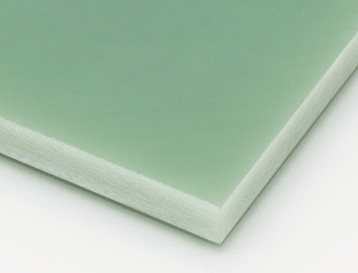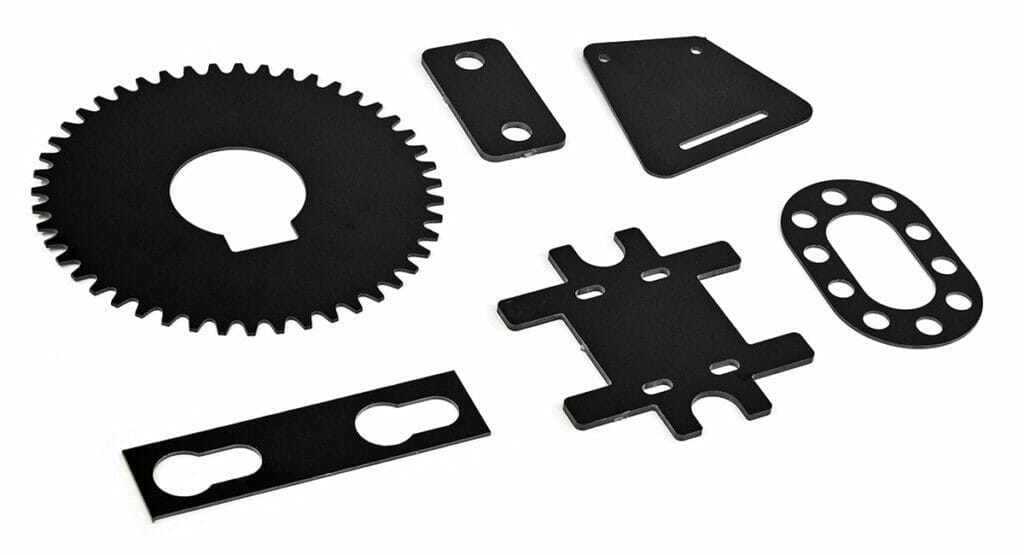G10 is one of our newest materials. In this article, we break down G10, what it is, its strengths and weaknesses and the best application use for this material.
What Is G10?
It is a composite/laminate made of a woven fiberglass cloth compressed under high pressure within a cured electrical grade epoxy resin. The number of cloth layers can vary, adding both strength and thickness. The specific make up of the epoxy use can also vary to give G10 different properties. Its construction has a lot in common with carbon fiber, the main difference being fiberglass woven cloth is used instead of carbon fiber cloth. G10 and FR4 are both grade designations from the National Electrical Manufacturers Association (NEMA). FR4 is essentially a fire resistant/flame retardant form of G10, but otherwise they are the same and we’ll refer to them here as a single material.
Specification
As we mentioned, G10 and FR4 grade materials are governed by both NEMA and military standards specifications. Being controlled by these standards means that the quality of G10 remains consistent versus other epoxy laminate materials. To be called G10 or FR4 requires that the material meet specific requirements. Requirements can be material composition, mechanical strength, electrical conductivity and how the material behaves if it catches fire to name a few. This is similar to the way many metals are classified, such as aluminums (2024, 5052, 6061, 7075), stainless steels (304, 316), titanium (grade 2, grade 5), steels (1075, 1095, 4130, AR400, AR500) as examples. You may also see G10 available under its branded name, Garolite.
Appearance
Natural G10 has a greenish-yellow color, but it can be found or made in nearly any combination of colors. Its layered construction is often used as a decorative element, with different colors alternating over the different layers. The G10 used by SendCutSend comes in a black color.


6 Benefits of G-10 Material
Electrical Resistivity
G10/FR4 was originally used in printed circuit boards (PCBs) and electronics and because of that it has excellent electrical resistance. It’s still used in all sorts of electronic components. When used in PCBs, a conductive copper layer is typically bonded to one side (or both). Specific patterns can be cut away from the copper leaving electrical traces on the circuit board.
Fire Resistance
The FR4 grade designation we use here at SendCutSend means that it meets the V-0 classification of the Underwriters Laboratories (UL) Standard for Safety of Flammability of Plastic Materials for Parts in Devices and Appliances testing (or the UL94 standard). That mouthful of words basically boils down to that when the material catches fire, it self-extinguishes in under 10 seconds. It won’t continue to burn as opposed to some other materials containing epoxy resin, which are known to be flammable.
Mechanical Strength
So far we’ve discussed the properties of G10/FR4 related to electrical applications, but one of the often overlooked benefits is its mechanical strength. G10 is an incredibly durable material. Its strength to weight is higher than 6061 aluminum and its tensile strength is nearly equivalent. That makes it a very durable material. Because it is a composite laminated material made from woven glass cloth, its strength characteristics are different depending on which direction the material is oriented. Its flexural strength helps keep its shape even under load.
Resistance to Water Absorption
G10 has excellent resistance to water absorption. Unlike steel, it doesn’t rust when exposed to moisture. Unlike wood based materials, it doesn’t absorb moisture and swell.
Chemical Resistance
Because G10 is made with epoxy, it has generally good resistance to chemicals. Stronger chemicals can have a negative impact, but G10 stands up well to more common substances such as alcohols, oils, even lighter concentrations of acids.
Thermal Stability
G10 has a low coefficient of thermal expansion. That makes it thermally stable compared to other materials, with minimal expansion and contraction with temperature.
G-10 Properties
The specific properties of G-10 can vary depending on the materials used to construct it, both the fiberglass cloth and epoxy resin and any additives. The properties of the FR4 you get from SendCutSend can be found on the materials page. We’ve also summarized it here, for convenience.
| Physical/Mechanical Properties of G10 | |
| Material Composition | G10 is a thermoset resin formed by the polymerization of phenol and formaldehyde, which can then be impregnated with glass cloth material to form an industrial laminate. |
| Density | 112.32 lb/ft^3 |
| Tensile Strength (Yield) | Lengthwise: 45 ksiCrosswise: 38ksi |
| Shear Strength | Lengthwise: 75 ksiCrosswise: 65 ksi |
| Comprehensive Strength | 65 ksi |
| Flexural Modulus | Lengthwise: 2.7 ksiCrosswise: 2.4 ksi |
| Isod Impact (Notched), ft-lb/in | Lengthwise: 13 ksiCrosswise: 14 ksi, 12 ksi |
| Rockwell Hardness | M110 |
| Thermal Conductivity | 2 BTU-in/hr-ft^2 °F |
| Flammability Ratings | VO |
| Magnetic | No |
| SendCutSend Specific Properties of G10 | |
| Cutting Process | Waterjet |
| Cut Tolerance | .009″ |
| Top/Bottom Finish | Identical both sides |
| Sourced from | USA |
Cutting
At SendCutSend, G10 is cut using our waterjet process. During the cutting process, we use tabs to hold the part in the sheet it’s being cut from. When ordering G10 parts you should be prepared to deal with any remaining tab material on your parts. See our page on Fixture Tabs for more information.
Downsides of G-10
UV Resistance
While the list of strengths is long, G10 is not without its weaknesses. Again, because G10 is made using epoxy it shares both strengths and weaknesses. As with most epoxies, they can break down with prolonged UV exposure. G10 may be fine in the sun for years, but over time it can start to degrade. Both its appearance and mechanical properties can be affected.
One way to mitigate this weakness is by applying a UV resistant coating. This can be as simple as a quality UV resistant clear coat paint.
Dust
Since G10 is made of both glass fiber and epoxy resins, the dust given off when it is cut or sanded can be an irritant. Remember to wear the appropriate protective gear if you need to do any cutting or sanding (but that’s true with just about any material). That can be avoided completely by having us do the cutting for you!
Applications and Uses of G-10

Electronics
By far the most common use for G10 is electronics. That’s why it was developed, and that’s where the specifications come from (NEMA). Its electrical resistivity makes it ideal for use in printed circuit boards, insulators, transformers, etc. Even in wet environments, it maintains its excellent electrical properties.
Knife Handles/Scales
The high strength to weight ratio of G10 also makes it great for use in mechanical applications. It can have a grippy texture, even when wet, making it great as a handle material. Knife makers use it to make handle scales. It’s similar to Micarta, another popular material for knife scales that is a compressed laminate using fabric instead of glass cloth.
Firearm Grips
Custom firearms manufacturers use it as handle grip panels. And because it’s a layered composite, it can be made in all sorts of custom colors for a decorative look. By having different colored layers, when a contoured shape is cut into the material it exposes the different layers creating interesting visual patterns. The material we carry here at SendCutSend is available in a solid black color.
Marine Components
The water absorption traits, or lack thereof, along with its strength and lightweight, make it a common material used in the marine industry. Chemical resistance also means it can be in a saltwater environment without suffering from corrosion. Not something that can be said about most materials. It does need to be protected from the sun as it can break down over time under UV exposure.
An Alternative to Fiberglass
G10 shares a lot of traits with fiberglass, as such it is an excellent choice anywhere fiberglass is used. FR4 fire resistant grade is an excellent choice where material flammability is a concern.
3D Printing
It’s often used as a print bed surface in 3D printers. Its thermal and dimensional stability means it stays flat, even when heated, and 3D printed material sticks to it very well.
Find Your Composite Match at SendCutSend
As you can see, G10 has a lot of advantages with few disadvantages. It’s strong and light, it has excellent thermal and electrical properties and is corrosion resistant. There aren’t many materials that make those claims. Can your next project benefit from all G10/FR4 has to offer? Visit the G10 materials page for all the specific details on this and all the other great materials and services SendCutSend has to offer. SendCutSend has the best options for composite materials for your laser cut projects, with no minimum quantities for orders and free shipping. Get your free quote today and see for yourself.





